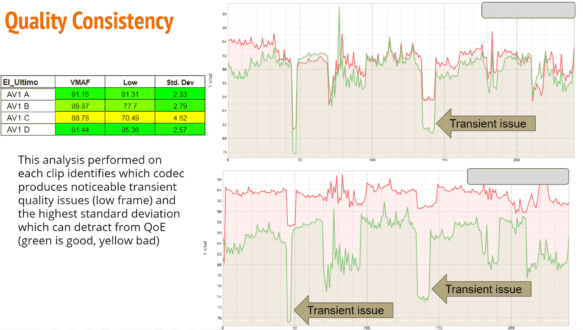 Jan Ozer here. I spent the last 2 months working with four AV1 codecs, benchmarking them against each other and x264 and x265. I’m presenting my findings in this for-fee 75-minute webinar ($149.99).
Jan Ozer here. I spent the last 2 months working with four AV1 codecs, benchmarking them against each other and x264 and x265. I’m presenting my findings in this for-fee 75-minute webinar ($149.99).
There are two parts; the first shares what I learned about the codecs, and the second details what I learned about encoding with them and creating the optimal command string. This started with input from the codec developers, and expanded into countless hours of reading documentation, running test encodes, and researching parameters used by Netflix, Facebook, and other researchers.
If you’re new to AV1 and are trying to learn which codec to use and which configuration options really matter, you’ll find this webinar invaluable. Anyway, join me if you can; here’s the official pitch.
Contents
Date: September 24, 2020
Time: 11:00 EST
Part 1: Choose the Best AV1 Codec
Several AV1 encoders (aomenc, libaom-av1, SVT-AV1) are available open-source, another (Aurora1) is only available via licensing. Is Aurora1 worth the price? This webinar will detail the encoding speed, quality (VMAF and SSIMPLUS), and quality consistency of four AV1 codecs.
Codecs Analyzed
- AOMedia aomenc (standalone executable)
- AOMedia libaom-AV1 (AV1 – codec in FFmpeg)
- Intel/Netflix SVT-AV1
- Visionular Aurora1 AV1 encoder
- Baseline codecs x265 and x264
Test Clips
- 16 real-world clips in five genres (Animation, gaming, movies, sports, other) (see details)
- Clips encoded at custom target bitrates that delivered VMAF scores between 85 to 95
Test Performed and Reported By Category
- Metrics – VMAF, SSIMPLUS, MS SSIM, SSIM
- Overall quality (BD-RATE computations and RD Curves) (see sample)
- Encoding speed
- Quality consistency (see sample)
What you will learn:
- How each AV1 codec compares in encoding speed, overall quality, and quality consistency
- How each AV1 codec compares to x264 and x265 in speed, overall quality, and quality consistency
Part 2: Use the Best AV1 Codec
Once you choose an AV1 codec, identifying the optimal command strings for the tests described above required a deep dive into AV1 encoding parameters and the available encoding controls for all four AV1 codecs. We received guidance from all the vendors, which we supplemented with independent research and analysis.
This included extensive tests to identify the appropriate preset for each codec, the optimal thread count, how to manage GOP size, data rate, and buffer settings, and which AV1 encoding parameters to enable and why. It also included an analysis of encoding strings used by Facebook, Netflix, and other researchers in their AV1 trials to make sure our strings were optimal.
You will learn:
- How to create optimal encoding strings for aomenc, libaom-AV1, SVT-AVT, and Aurora1
- Which encoding preset delivers the optimal blend of encoding speed and quality for production and testing
- How these strings compared to encoding parameters used by Netflix, Facebook, and other researchers in publicly available testing
- The optimal thread count to use for each codec and the optimal encoding station configuration
If you’re experimenting with these codecs, or plan to soon, this course will save you hours and hours of experimentation.
Date: September 24, 2020
Time: 11:00 EST
Note: Some of the information presented in Part 1 of this webinar (performance, encoding strings, and overall results for VMAF and SSIMPLUS) will appear in a Streaming Media article in the September issue, which just shipped and should hit the web soon. This article does not present clip or genre-specific results, results for SSIM or MS SSSIM, or quality consistency data. It does not contain any of the analysis presented in Part 2 of this webinar.
 Streaming Learning Center Where Streaming Professionals Learn to Excel
Streaming Learning Center Where Streaming Professionals Learn to Excel










